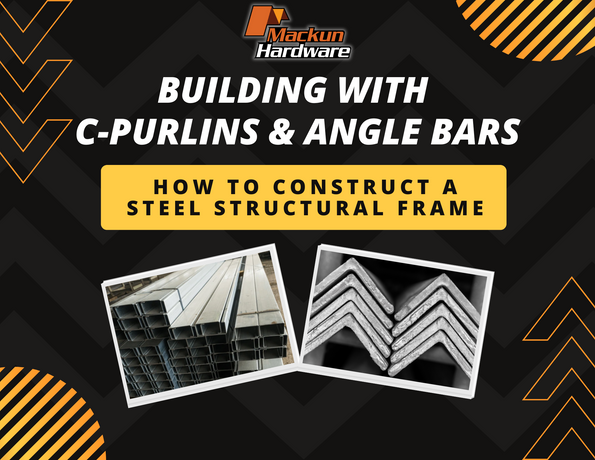Heads up!
Limited stock on popular items.
Verify availability before you order!
- No products in the cart.
Heads up!
Limited stock on popular items.
Verify availability before you order!

When constructing a sturdy framework for buildings, C-purlins and angle bars are two essential materials that provide structural strength and durability. This guide will help you understand C-Purlins and Angle Bars, their functions, benefits, and best practices for creating a strong structural frame.


C-purlins are C-shaped metal beams typically made from galvanized steel. They are commonly used in:
Roof framing—for industrial buildings, commercial spaces, and residential structures
Wall framing—for warehouses and steel structures
Floor joists—for bridging support in multi-level constructions


Angle bars, also known as L-brackets or angle irons, are steel bars bent at a 90-degree angle. These are commonly used for:
Structural framing – Reinforcing columns, beams, and trusses
Bracing and support – Providing extra stability for walls and roofs
Metal framework fabrication – Used in doors, windows, and shelving systems
A. Planning and Design
Before starting construction, it’s crucial to create a plan that outlines:
The sizes and spacing of C-purlins and angle bars
The expected load capacity and weight distribution
Proper fastening and welding points
Hiring an engineer or structural expert ensures that your building frame meets Philippine building standards.

B. 3 Steps for Choosing the Right Materials
Select high-quality steel – Look for C-purlins and angle bars made from galvanized or mild steel for durability and corrosion resistance.
Check the thickness and gauge – Standard C-purlins range from 1.2mm to 3.0mm in thickness, while angle bars vary from 3mm to 12mm. Choose based on the load-bearing needs of your structure.
Inspect for defects – Avoid materials with excess rust, warping, or inconsistent thickness.


1. Preparing the Foundation
Mark the layout and secure anchor points for the structural frame.
Ensure that the foundation is level and capable of supporting the steel framework.
2. Installing C-Purlins
For roof framing – Position C-purlins perpendicular to rafters and fasten them using bolts, screws, or welding.
For wall support – Attach C-purlins horizontally between vertical steel columns to create a strong backbone for walls.
Maintain proper spacing (typically 600mm to 1,500mm apart) to ensure stability.
3. Securing Angle Bars
For framing – Weld or bolt angle bars at key joint points to reinforce the structure.
For bracing – Use angle bars diagonally across frames to prevent lateral movement and improve load distribution.
4. Fastening and Reinforcement
Use high-quality bolts, screws, or welding techniques to secure connections.
Apply anti-corrosion coatings or paint to prolong the lifespan of steel components.
Perform load tests before proceeding with the next phase of construction.
C-purlins and angle bars are essential components for constructing strong, reliable frameworks. By choosing the right materials, following proper installation techniques, and ensuring regular maintenance, you can build a structure that is both durable and cost-efficient.
For larger projects, always consult with an engineer to ensure compliance with Philippine construction standards.
We hope this guide was helpful! If you need more assistance, our team at Mackun Hardware is always ready to help.
Check out our stock of C-purlins, angle bars, and their prices.

For inquiries and orders you may visit or contact us:
Address: RW Building, Sergio Osmeña Street Cagayan de Oro City, Misamis Oriental 9000
Contact No. : +63 956 037 2805
| Product | Price | Quantity | Options | |||||
|---|---|---|---|---|---|---|---|---|
| Features |
| Availability: |
| Price |
| Options |
| Actions |
